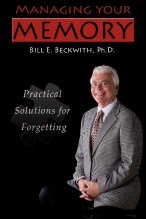What Should I do if I am Risk for Alzheimer’s Disease: Part II
To review from last week, the brain changes associated with Alzheimer’s disease are found 25 years before onset of symptoms. This finding is based on longitudinal study of families with a particularly aggressive form of Alzheimer’s disease and can probably be extrapolated to the late onset form of the disease. Furthermore, memory decline starts 10 years before symptoms and current medical screening (the MMSE) does not detect changes until 5 years before symptoms. In short, Alzheimer’s disease unfolds over a very long time. It gives us opportunity to develop a comprehensive wellness plan.
What does this mean for me and for my clients? There is hope for better managing memory disorders such as Alzheimer’s disease. So often I hear “Why should I address memory issues as there is nothing I can do?” This adds to the feelings of hopelessness and fear. There is time to get a long range plan in place as long as we don’t wait for a diagnosis (which can only be made decades into the disease). The four pillars of long term wellness are advanced directives, financial planning, physical health, and cognitive/memory health.
First, consider advanced directives. These are legal documents that outline who will manage my medical and financial decisions should I become incompetent (e.g. from a stroke, from a brain injury in the future). The Living Will adds guidance to my family for end of life decisions such as whether I want a feeding tube, whether I want my life extended by artificial means if there is no hope for future quality of life. Many have these documents by mid life. I suggest to my clients that they add plans for monitoring skills such as driving and finances to the plans. These are protections we hope not to ever need but so much the worse for those we love if these plans are not in place.
Second, we also are proactive about finances. Most of us have long range saving and investment plans (e.g., social security, IRAs) for having money available when we wish to work less. We willingly seek financial and investment counselors to help us establish and monitor this plan usually when we are early in our work career. We add insurance to protect us against catastrophic loss of resources or add to our taking care of loved ones. Many even plan for and prepay funeral arrangements.
Third, we are proactive about our health. We seek out advice from our primary care physicians that help us avoid or better manage long term health and wellness. We monitor important body functions to allow early detection of changes before disease sets in or to find it early and manage the course better. For example, we monitor heart function through physicals and blood work, stress tests, heart scans. We monitor for cancer by physical exams, blood tests, and screenings such as colonoscopies. We monitor for chronic diseases such as diabetes and hypothyroidism by serial screenings of thyroid function and blood sugars.
However, we leave the fourth pillar of wellness, memory and cognitive health to chance. We are fearful of being proactive. We succumb to clever marketing based on fear rather than facts. Part three of this series will outline a proactive plan for managing cognitive wellness.




